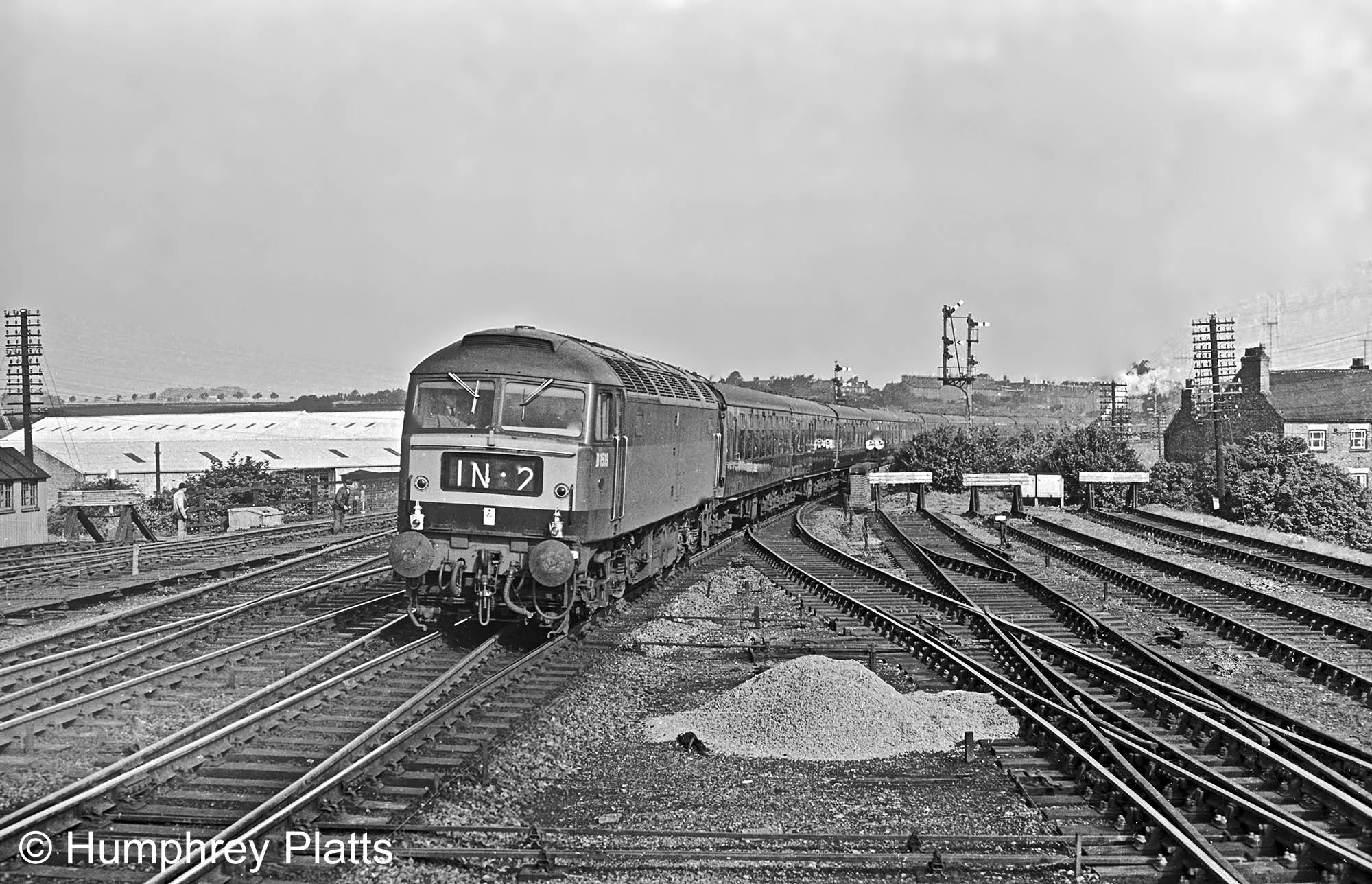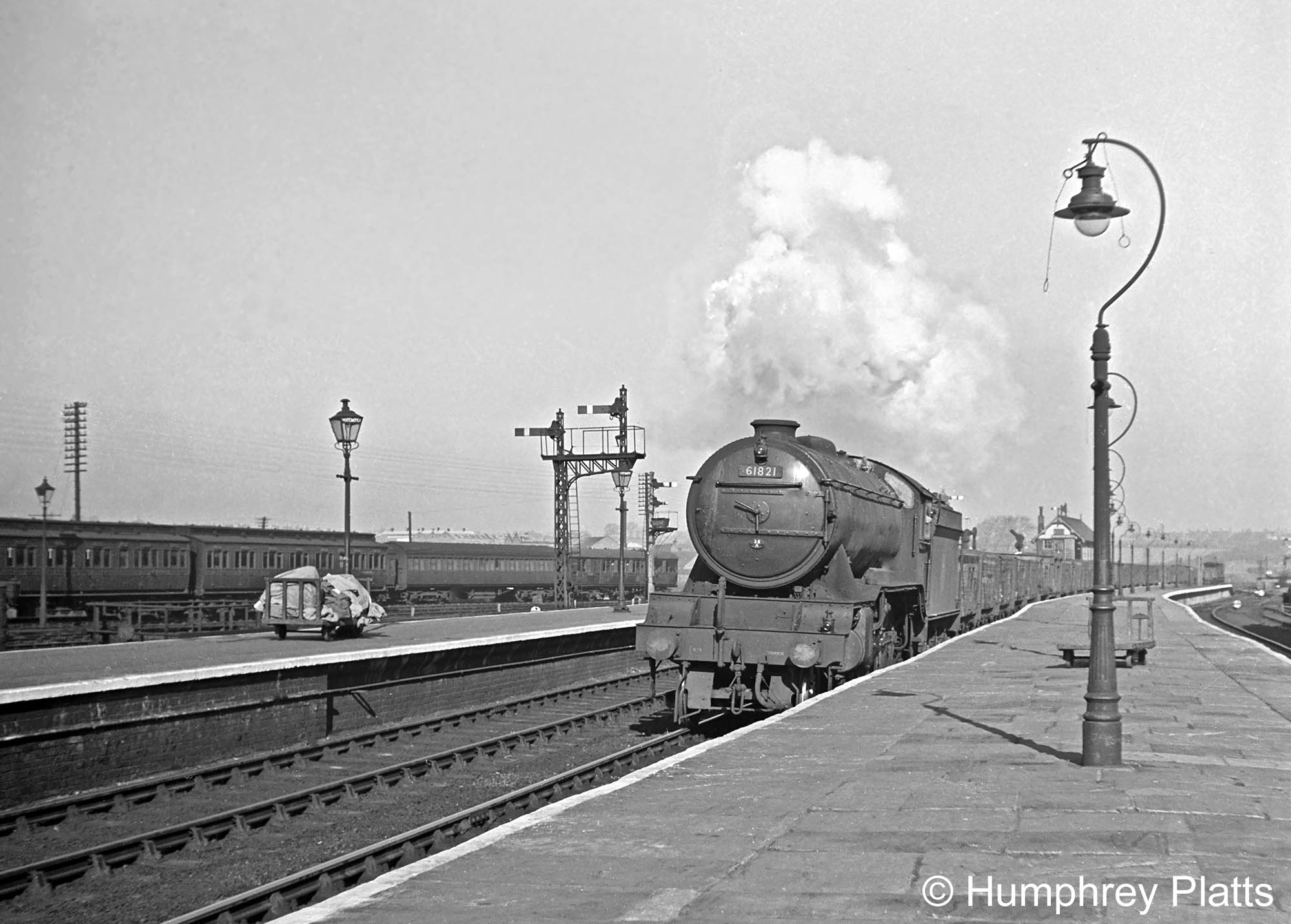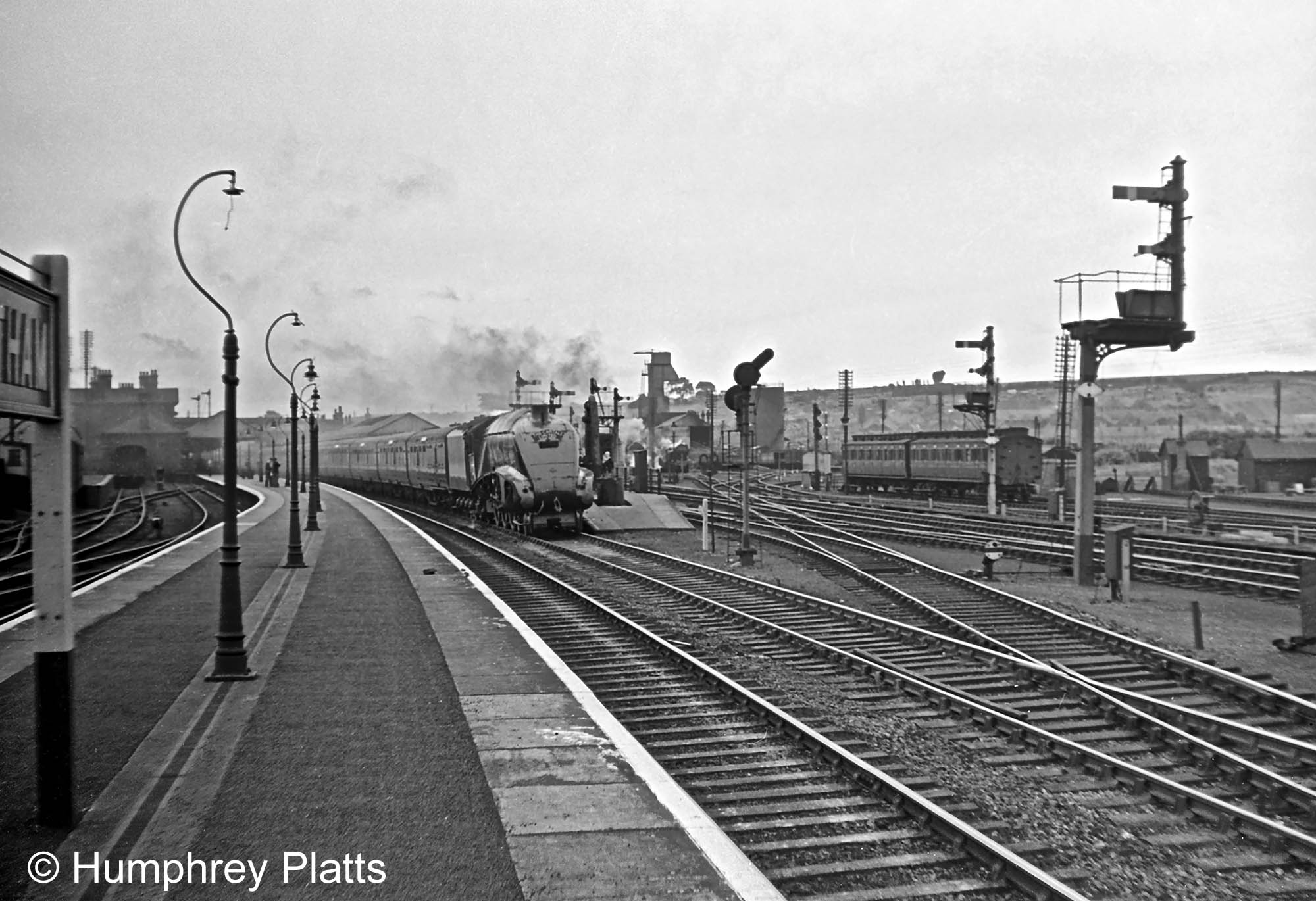My Railway Photography
When a boy of seventeen I was given a Kodak VPK camera which used 127 film. This was in 1946, when photography was possible again after the Second World War had ended.
My railway photography began at Northwood in Middlesex, on the Metropolitan and Great Central Joint line from the London stations at Baker Street and Marylebone. London Transport and the LNER shared the electrified tracks which ended at Rickmansworth, where ex-GCR 4-6-2 tank locomotives (A5s) then took LT trains on to Aylesbury. The LNER ran both local and express trains on the GC, so main line engines were also photographed. I also took many pictures of the GWR and LMS railway scene at Shrewsbury, and of the Southern Railway main line from Waterloo to Bournemouth.
In 1949 I came to Grantham to join the tannery company of Bjorlow (Great Britain) Ltd., and so I began to photograph the railways of this area. I was familiar with the East Coast Main Line from visits to good vantage points between Potters Bar and Brookmans Park on the Middlesex/Hertfordshire border. Here I could photograph trains coming from or going to places in 'the north'. My camera at this time was a Voigtländer, taking 6 x 6 negatives on 120 black and white film. Later I bought a second-hand Contax 35mm camera. I did all my own developing and printing.
Some of my pictures were included in an exhibition at Grantham Guildhall to mark the 1952 Centenary of the opening of the ‘Towns Line’ railway through Grantham.

From The British Newspaper Archive http://www.britishnewspaperarchive.co.uk/
Image © THE BRITISH LIBRARY BOARD. ALL RIGHTS RESERVED.
The earliest photographs in my collection date from 1949-50. Inevitably they are mainly of the trains, but I hope that features of the station, the ‘Loco’, and the surrounding area make interesting comparison with later times and with the present.
We are sorry to add this footnote to say that Humphrey Platts passed away in December 2024, aged 95. He was an enthusiastic supporter of Tracks through Grantham who contributed many more of his photographs and memories, some of which feature on these pages:
- The Plant Centenarian calls at Grantham, Sunday 27th September 1953
- Flying Scotsman's stopover at Grantham, October 1973
Gonerby, Barkston and Peascliffe







Note the tall telegraph poles in use at this time - gone completely now!

This class was very familiar to me in the 1940s on the Met & GC (Metropolitan and Great Central) line in Middlesex.



Grantham Station - main lines, running in from the north

On the left is a lamp cabin, where oil lamps for the signals at the north end of the station were filled and trimmed. The tall structure immediately to the right of the telegraph poles is part of the works of the Grantham Boiler & Crank Company.

Scroll down for a closer look at the left background...

The buildings low down, nearest the camera, are on the far side of Harlaxton Road and were part of the steam plough works of Henry Yates & Co. in the 1870s-1880s.
Clustered around the tall chimney are the extensive grain mill buildings of Henry Bell & Co. (Grantham) Ltd. on Old Wharf Road. The company is still in business in Grantham although at a different site, on Dysart Road.
Behind the tallest of the mill buidings, and just to the left of the chimney, are the twin gables of the by-this-time roofless warehouse at Ambergate Yard, Grantham's original railway terminus. The top floor of the Ambergate station building is to its right, behind the building with the circular aperture in its gable end.
In the distance, far beyond the tall chimney, is the Phoenix Iron Works, built in the 1870s and at this time occupied by crane manufacturer R.H. Neal & Co. Ltd., whose name is painted on the roof.

This locomotive was completed at Crewe Works in March 1958 and spent all its short 6-year working life based at Doncaster shed.

The locomotive is carrying two oil-lit headlamps (one above each buffer) indicating a Class 1 express passenger train. On most diesels the headcode panel, equipped with four roller blinds showing a combination of numbers and letters and therefore conveying much more information, was supposed to have replaced the steam-age oil lamps. However, if the panel's indication was not to be relied upon resort was made to the old system.

On the left is Grantham North signal box. The brick base was originally built with windows but you can see that the window apertures have been filled with solid brickwork. This was carried out at the beginning of World War 2 to give additional protection to the locking frame in the event of air raids. The locking frame is a complex mechanical and electrical logic mechanism which occupies the space beneath the working floor of a signal box. Essential for the safe operation of the many signals and points at complex and intensively worked locations such as the north end of Grantham station, it might take weeks to repair or replace had it been seriously damaged.

Above the far end of the signal box roof a lampman (or possibly a signals and telegraph fitter) is attending to the Nottingham line's starting signal.
There's also good detail of the Up bay starting signal and the rather ugly replacement electric lamp standard (in comparison with the shapely gas lamp posts evident in my earlier photographs).


Note the different pattern of platform lighting on the up and down platforms. This arose because the northern ends of the two platforms were built, altered and extended at different dates.

Evidence of the extended platforms noted above is visible in this view. The wall supporting the down platform, opposite, shows a change in alignment while, on the right, opposite the fourth wagon of the train, the platform ramps up slightly to the level of the newer section.
Grantham Station - departing for the south

The engine has 'COLWICK' painted on its front buffer beam, its home shed from 1935 until 8th January 1950. However, the oval plate on the smokebox door bears the code '40F' for Boston, its home shed after that date.
The single head lamp carried in front of the chimney indicates that the train is a stopping passenger service. The front coach has 'BOSTON' painted on the end. So we can probably conclude that this is an 'all stations' service from Boston.


In the background is the Aveling Barford engineering factory where earthmoving equipment was made, much of which left Grantham by rail.
Grantham Station - departing for the north


On the right is a gradient post, indicating level track through the station (which is normal, as a safety precaution so that vehicles cannot roll away by themselves) and 1 in 330, or 16 feet per mile, downhill to the north.


The nameplate was fiited in July 1950, and the locomotive was carrying the early British Railways express passenger engine blue livery at this time.



To the left of the nearest lamp post we get an approaching driver's view of the tall co-acting signals at the south end of the station next to the Yard Box - through the haze of smoke drifting across the station and towards the southern part of the town from the Loco,
Note that the two nearest platform lamp standards have no lamps attached.
Grantham Station - north bays and Western platform


This photograph includes a good outline of one type of lamp standard on the Western platform - platform 5 - and a silhouette of some detail of the overhead canopy of the bay platform, No. 4.
Three engines can be glimpsed on the shed in the left background, including a very clean B12 4-6-0. In the right background, behind the lamp post, is the cabin where 'foreign' locomotive crews would take their break while awaiting a return working.



No. 60015 appears to be in early BR blue livery; if it is, this would place the date of the photograph between November 1949 and October 1951.
In the left background are various huts belonging to the engineer's department. It is said that some of these huts came from the First World War machine gun corps training camp at nearby Belton Park.
At far left. beyond the huts, the tall smoking chimney identifies the gas works near the canal basin. Coal was delivered to the gas works by rail using the branch from Barrowby Road junction to Ambergate Yard.
In the foreground, the main line tracks are both still laid in bullhead rail.
Grantham Station - goods line and Loco yard

The bracketed signal post in the foreground is the starting signal from the bay platform for the Nottingham line (left hand arm) or the main line. The disc signal behind and to its left permits a locomotive to leave the engine spur to take over a northbound train on the main line. All signals and points in this photograph were controlled by Grantham North signal box.

On the right is a fogman's hut. When brought into use in foggy weather or falling snow it was pushed upright and gave shelter to a man whose task was to place detonators (fog signals) on the rail whenever the adjacent signal was at danger or caution. Thus a driver who missed the signal in the poor visibility received an audible warning by the sound of these small explosive charges being set off by the locomotive's wheels. When the signal cleared the detonators had to be removed.

On the far left two spotters are sitting on a pile of telegraph poles.


The tracks on which the four brake vans and the two O2 locos facing south are standing, and the pair of tracks between them, used to be covered by the four-road 'old shed', part of whose back wall can be seen just beyond the mineral wagon. The 'Peak' stands on a siding that was beside the shed, and is where the Grantham breakdown train used to be stabled.
Throughout the Loco yard electric lighting has replaced the old gas lamps which were visible in the 1950s. photographs.
Back to Grantham Railway Galleries
Copyright note: the article above is published with the appropriate permissions. For information about copyright of the content of Tracks through Grantham please read our Copyright page

Love the pictures. I wonder if that is my grandad driving Great Northern? It was one he drove regularly. His name was William Bell, I don't suppose you would have any photos of him as I don't have any? He died when I was very young, on the footplate just before Christmas. If you have any info on my grandad I would be very interested.
Hello Joe
I am glad to know that you like the pictures! Thank you for your words about your grandad driving "Great Northern". I regret that I do not have a photo of him for you. Perhaps someone will read this who does know of a photo. I found a picture of this rebuilt engine at King's Cross in 1946 in LNER livery and its then '4470' number.
Humphrey Platts' pictures at Barkston and Grantham bring back fond memories, especially the shot of of Barkston station and the branch waiting room from the Jericho Wood goods yard gate.
Also V2 60935, being held next to the slow road from which Mallard had started its world record breaking run several years earlier; and Atlantic 62822, the only atlantic to ever have a smokebox number.
Happy memories.
Peter.
Hello Peter,
Thanks very much for your recent contribution. I'll tell Humphrey you've been in touch; the shot of Barkston station was a very recent 'find' of his.
John Clayson
Superb photographs. Great to see Grantham station and Barkston junction station as they used to be in the early 60s. Hopefully more such photos will follow.
Some superb photos by Humphrey Platts bringing back lots of memories of my spotting days at Grantham.
I moved to Melbourne Australia in the early '90s but still visit the UK when I can.
I made a special trip back when the "Great Gathering" of A4's took place.
Wonderful photos. I particularly liked the D3 and the J52/1 shots. Thank you.
Humphrey,
Your shot of station pilot 67382 is magic - the positioning of the engine with the ornate station canopy and all, makes this a very artistic set up. Well done, especially with the photographic constraints of the era in which it was recorded!
Great pictures of a wonderful era for the steam enthusiast. Love the early 50s stuff, well before my time! Just one error to point out, in the picture of 65496 you state that it is a J6 when it is in fact a J5.
Hello Tony. Thank you for your kind comment about Tracks through Grantham. We've amended 65496's caption - and well spotted, because the page has been 'live' for more than 7 years and no one's picked up the mistake until now.
Kind regards,
John Clayson
Just seen Tony's recent comment on my steam era photos. I enjoy looking at them again too. I am now 94 years old.
Humphrey Platts.
After Humphrey's recent passing it has been an absolute pleasure to revisit these photos. Their quality is outstanding and they are a fine tribute to a fine man.